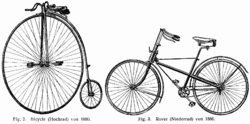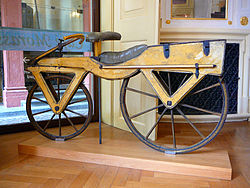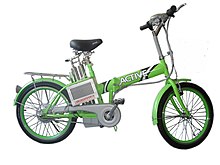


A bicycle (or bike) is a small, human powered land vehicle with a seat, two wheels, two pedals, and a metal chain connected to cogs on the pedals and rear wheel. A frame gives the bike strength, and the other parts are attached to the frame. The name comes from these two words - the prefix "bi-" meaning two, and the suffix "-cycle" meaning wheel. It is powered by a person riding on top, who pushes the pedals around with his or her feet.
Riding bicycles, which is also called cycling, is an important way to travel in several parts of the world. The most popular type of cycling is Utility cycling. It is also a common recreation, a good form of low-impact exercise, and a popular sport. Road bicycle racing is the second most popular spectator sport in the world. Bicycling uses less energy per mile than any other human transport.[1]

Invention
[change | change source]
In 1817 a German professor, Baron Karl von Drais, created the first two-wheeled bicycle. It was made of wood and had two wheels. The front wheel could be turned using the handlebars in order to steer the bike. However, it did not have pedals, so the rider would have to push their feet on the ground to make it move.
In the 1860s, French inventors added pedals to the front wheel. However, it took a lot of effort to turn the pedals. Later inventors made bikes out of metal only, and made the front wheel very big, giving higher speed. This design was called the penny-farthing bicycle. However, it was difficult to ride, since it could fall easily and the rider would fall far.
Several improvements were made in the 1880s and '90s. In 1885, the safety bicycle was invented. This had two wheels the same size so that the rider could sit at a lower height. It was called the safety bicycle because it much easier to ride than the penny-farthing. When stopping, the rider can simply put down a foot instead of completely dismounting. Instead of pedaling and steering with the front wheel, the safety bicycle steers with the front wheel while the pedals turn the back wheel using a chain. Brakes operated by hand levers on some bikes also increased safety.
In 1888, Scottish inventor John Boyd Dunlop re-invented a type of tire which was filled with air. This made safety bicycles more comfortable. Soon, the freewheel was invented. This was a device inside the hub of the back wheel that allowed the wheel to spin even if the rider wasn't pedaling. However, this meant the rider could no longer stop the bike by backpedaling. As a result, better hand brakes were invented, and a different type of brake which could stop the bike if the pedals were turned backwards. Later inventions included better brakes, and gears which made cycling over hills much easier. During this time the bicycle became very popular.
Basic Design
[change | change source]Basic components common to most bikes include a seat, pedals, gearing, handlebar, wheels, and brakes, all mounted on a frame. The majority also have a gear shifter. The cyclist's feet push the pedals to make them go around in circles, which moves the chain, which turns the back wheel of the bike to make the bike move forwards. The front wheel is connected to the handlebar, so turning the handlebar from side to side swivels the front wheel which steers the bike.
Types of Bicycles
[change | change source]


- The city bicycle is made for errands and commuting in cities. It has a comfortable seat but is heavy. It has front and back lights and a bell, and carriers for small cargoes. It has mudguards to keep water and mud from spraying the rider. The rider sits upright for comfort and easy steering in traffic. "Bike share" systems usually provide " city-style bikes".
- The mountain bicycle is used for riding on rough roads. They have many speeds (usually more than 20), wide tires, and strong wheels. The tire is specially designed to ride smoothly on hills, grass, and mountains.


- The difference between a woman's bicycle and other bicycles is the location of the top tube. When women began to ride bikes, they wore long skirts. The manufacturers of bicycles changed the location of the top tube to make it easier for women to sit down on them while wearing a skirt. Some utility bicycles are similar, for riders who make frequent stops.
- The tandem bicycle is made for two people. It has two pairs of pedals. The cyclists sit one behind another. The first cyclist steers the bicycle. There are bicycles for three and more people. There was a bicycle for 40 people.
- Folding bicycles can easily be stored in a small place or carried a long distance on an airplane or other public transport.
- Electric Bicycles have electric motors, usually inside the hub of either the front or rear wheel. You can choose to ride using the motor only, or with pedals only or with both together. In the U.S. the federal government has set a limit of 750 Watts and a top electric-powered speed of 20MPH to have only the rules that apply to bicycles and no extra restrictions such as operator license, vehicle license, registration or insurance requirements.
- A road bicycle usually has narrow wheels, less than 1" (25 mm) wide, with a frame that is much lighter than a mountain bicycle. Road bikes are efficient for longer distances. Many have clips to attach your shoes, rather than just pedals. There are variations, as some road bicycles have regular tires. Road bicycle racing is a popular sport.
- Recumbent bicycles come in several styles, but all of them have pedals in front of the seat, and the rider leans back while riding. This is more comfortable for most people, but cost more. Some types are lower to the ground, so it might be harder to see in traffic. The fastest bikes in the world are recumbents.[2]
Safety
[change | change source]Many thousands of people are hurt every year in bicycle accidents, and hundreds die.[3] Careful riding helps prevent accidents. When riding on streets, it is safest to ride on the same side of the street that cars drive (which would mean riding on the right side of the road in countries where people drive on the right side of the road, and riding on the left in countries where people drive on the left). To avoid hitting people, riders must obey signs that say "no bicycling", even if it does not seem to make sense at the time. Low light makes bicycle lighting important. It may not be safe to ride when it is dark. Riders wear reflective clothing to be safer in low light. Wearing a helmet makes bicycle riding safer. Wearing a helmet does not mean that somebody cannot be hurt if they crash their bicycle, but it makes being hurt less likely.[4] Some bicycles have bells or horns that the rider can use to warn other people that they are riding by them.
Many places have a bicycle path linking houses with shops, schools and stations. These make bicycling safer, letting cyclists stay away from busy motor traffic on dangerous roads.
Related pages
[change | change source]- Bicycle-sharing system
- Fixed-gear bicycle
- Mountain biking
- Tandem trike
- Tour de France
- Tricycle
- Unicycle
- World Bicycle Day
References
[change | change source]- ↑ "Science of Cycling: Human Power". www.exploratorium.edu. p. 1. Retrieved 2007-08-11.
- ↑ "Land speed records (unpaced)". IHPVA. Retrieved 5 January 2017.
- ↑ I, Steve (2018-04-23). "Bicycle Accidents in the United States". People Powered Movement. Retrieved 2020-11-04.
- ↑ "Helmets: How they Work and What Standards Do". bhsi.org. Retrieved July 29, 2010.